History of the Islands
- Details
- Created on 17 February 2013
- Last Updated on 05 April 2013
Formation of the Islands




From the First Settlement Until Today
 In antiquity the archipelago was called Demonisia, the People’s Isles. During Byzantine times the archipelago came to be known as Papadonisia, the Islands of the Monks, from the many monasteries that had been established on the various isles. These monasteries became famous for the emperors, empresses, and patriarchs who were exiled there, some of them never to return to Constantinople. According to the Byzantine chronicler Kedrenos, the emperor Justin II (r. 565-78) built himself a palace and monastery on the largest of the islands in 569. This isle had been known as Megale, or the Great, but after the emperor established residence there it came to be called Prinkipo, the Isle of the Prince. Later the entire archipelago came to be called the Prinkiponisos, or the Princes’ Isles.
In antiquity the archipelago was called Demonisia, the People’s Isles. During Byzantine times the archipelago came to be known as Papadonisia, the Islands of the Monks, from the many monasteries that had been established on the various isles. These monasteries became famous for the emperors, empresses, and patriarchs who were exiled there, some of them never to return to Constantinople. According to the Byzantine chronicler Kedrenos, the emperor Justin II (r. 565-78) built himself a palace and monastery on the largest of the islands in 569. This isle had been known as Megale, or the Great, but after the emperor established residence there it came to be called Prinkipo, the Isle of the Prince. Later the entire archipelago came to be called the Prinkiponisos, or the Princes’ Isles.
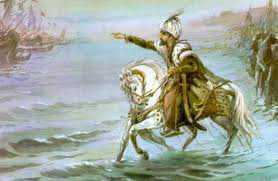
During the Byzantine era, when Constantinople was protected by its great walls, the Princes’ Isles were left exposed and were ravaged during enemy sieges. This was particularly so in the Arab invasions of the seventh and eighth centuries, in the sack of Constantinople by the Venetians and the knights of the Fourth Crusade in 1204, and in the attacks that led up to the capture of the Byzantine capital in 1453 by the Ottomans under Mehmet II. The islands were secure under Ottoman rule, though in 1807 a squadron of the British Navy under Admiral Sir John Duckworth forced its way through the Dardanelles and the Marmara and anchored off Kınalıada for eleven days, during which time they bombarded the island before sailing back to the Aegean.
During the Byzantine era, Antigoni, Halki and Prinkipo were inhabited almost entirely by the families of Greek fishermen and mariners, while Armenians predominated on Proti. During the late Ottoman era, prosperous Turkish and Jewish families took up residence on the islands as well, particularly on Büyükada, along with a few foreign diplomats and businessmen. There are still significant Armenian and Jewish communities on some of the islands, and also a number of Greeks, but today the vast majority of the islanders are Turkish.
Chronological History of the Princes' Islands

The First Ferries to the Islands
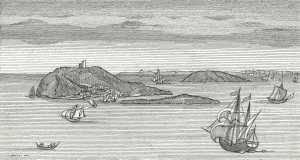 The first ferries to the islands, beginning in the eighteenth century, were the large rowing craft known as "pazar kayık". Small steam-powered ferries made their appearance in 1846, to be followed by larger steamboats when the Şirket-i Hayriye began regularly scheduled ferry service to the islands at the beginning of the second half of the nineteenth century. This led to a great increase in the population of the islands, both in the number of year-round residents and those with summer homes. There was also a huge influx of day-trippers and overnight visitors on weekends and holidays, which led to the erection of hotels on the larger islands, although there are fewer hostels now than there were in times past. The ferry service has been expanded in recent years, with high-speed sea buses going out to the islands from Kabataş on the Bosphorus in addition to the regular ferryboats from the Adalar station on the Golden Horn. Despite these developments, the archipelago is still largely unspoiled, particularly because automotive transport is banned, except for a few municipal vehicles. Otherwise the only means of transport on Burgazada, Heybeliada and Büyükada is by fayton, or horse-drawn carriage, while on Kınalıada one must either walk or ride a bicycle.
The first ferries to the islands, beginning in the eighteenth century, were the large rowing craft known as "pazar kayık". Small steam-powered ferries made their appearance in 1846, to be followed by larger steamboats when the Şirket-i Hayriye began regularly scheduled ferry service to the islands at the beginning of the second half of the nineteenth century. This led to a great increase in the population of the islands, both in the number of year-round residents and those with summer homes. There was also a huge influx of day-trippers and overnight visitors on weekends and holidays, which led to the erection of hotels on the larger islands, although there are fewer hostels now than there were in times past. The ferry service has been expanded in recent years, with high-speed sea buses going out to the islands from Kabataş on the Bosphorus in addition to the regular ferryboats from the Adalar station on the Golden Horn. Despite these developments, the archipelago is still largely unspoiled, particularly because automotive transport is banned, except for a few municipal vehicles. Otherwise the only means of transport on Burgazada, Heybeliada and Büyükada is by fayton, or horse-drawn carriage, while on Kınalıada one must either walk or ride a bicycle.
The Names of the Islands in History
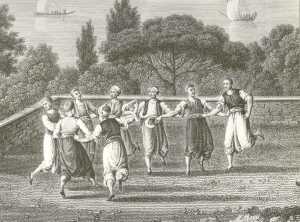 In antiquity the archipelago was called Demonisia, the People’s Isles. During Byzantine times the archipelago came to be known as Papadonisia, the Islands of the Monks, from the many monasteries that had been established on the various isles. The emperor Justin II (r. 565-78) built himself a palace and monastery on the largest of the islands in 569. This isle had been known as Megale, or the Great, but after the emperor established residence there it came to be called Prinkipo, the Isle of the Prince. Later the entire archipelago came to be called the Prinkiponisos, or the Princes’ Isles..
In antiquity the archipelago was called Demonisia, the People’s Isles. During Byzantine times the archipelago came to be known as Papadonisia, the Islands of the Monks, from the many monasteries that had been established on the various isles. The emperor Justin II (r. 565-78) built himself a palace and monastery on the largest of the islands in 569. This isle had been known as Megale, or the Great, but after the emperor established residence there it came to be called Prinkipo, the Isle of the Prince. Later the entire archipelago came to be called the Prinkiponisos, or the Princes’ Isles..
Büyükada - Prinkipo
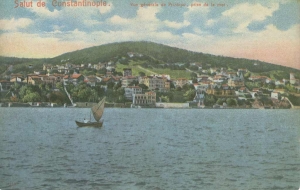 The island is rich in historical associations. The earliest of these concern the palace built in 569 by Justin II (r. 565-78), nephew and successor of Justinian (r. 527-65). According to the chronicler Kedrenos, Justin had a "farm estate" on the island, on which he built his palace and probably also a monastery. The name of the monastery is unknown, although it is believed to be the convent where several empresses of Byzantium and at least one emperor were confined during their periods of exile.
The island is rich in historical associations. The earliest of these concern the palace built in 569 by Justin II (r. 565-78), nephew and successor of Justinian (r. 527-65). According to the chronicler Kedrenos, Justin had a "farm estate" on the island, on which he built his palace and probably also a monastery. The name of the monastery is unknown, although it is believed to be the convent where several empresses of Byzantium and at least one emperor were confined during their periods of exile.
The palace and convent are believed to have been on the northeastern shore of the island in the district now known as Maden, or the "Mine," so called because of the iron mine that was worked there in the mid-nineteenth century. The archaeological evidence to support this includes a capital bearing a monogram with the name of the empress Sophia, wife of Justin II. Another capital with a monogram giving the name of the emperor himself was found in the present church of St. Dimitrios in the village of Büyükada.
Ernest Mamboury, in a paper published in 1943, reported on archaeological finds he made in the Maden district, in an area known as Kamares, or the "Arches," doubtless from the ruins that were then still visible there. Mamboury estimated that the convent occupied an area of about 300 square meters, its north and south wings each about 250 meters long, with the ruins of the conventual church still evident within the enclosure. However, these remains have now utterly disappeared.
The convent was rebuilt and enlarged by the empress Eirene (r. 797-802), one of the few women to rule Byzantium in her own right. Eirene was the wife of Leo IV (r. 775-80) and mother of his son and successor, Constantine VI (r. 780-97). Constantine was only ten when he succeeded to the throne, and so his mother Eirene was made regent and immediately began restoring icons to the churches of Byzantium, from which they had been banned by the iconoclastic policy of her late husband. Constantine took power in 790 and confined his mother to the palace, but he proved incapable of rule and two years later he released Eirene and crowned her as co-emperor. Then in 797 Eirene and her supporters overthrew Constantine, who was blinded by his mother and sent into exile in the convent that the empress had founded on Prinkipo. Constantine died a few days later and was buried in the graveyard of the convent.
Eirene thus became the first woman ever to rule the Byzantine Empire on her own, though her unnatural crime profoundly shocked Constantinople. As the chronicler Theophanes wrote: "And the sun was darkened during seventeen days, and gave not his light, so that ships ran off course, and all men said and confess that because the emperor was blinded, the sun had put away his rays. And in this way power came into the hands of Eirene, his mother."
Eirene ruled on her own for more than five years, but then on 31 October 802 she was deposed in a palace coup, to be succeeded by Nicephorus I (r. 802-11). Eirene was then exiled, first to her convent on Prinkipo and then to the island of Lesbos in the Aegean, where she died the following year. Her remains were brought back and buried in the graveyard of her convent on Prinkipo, laid to rest beside her son Constantine. Their graves were tended by the Princess Euphrosyne, who had been exiled to the convent with her father. Euphrosyne remained in the convent for twenty-seven years; she was finally released in 824 to become the bride of the recently widowed Michael II (r. 820-9), a usuper of plebian origins who married the princess to lend legitimacy to his reign.
The next imperial exile in the convent was the empress Zoe, daughter of Constantine VIII (r. 1025-8) and wife in turn of Romanus III Argyrus (r. 1028-34), Michael IV (r. 1034-41), and Constantine IX Monomachus (r. 1042-55). After the death of Michael IV the succession passed to Michael V (r. 1041-2), the adopted son of Zoe, who turned on his foster mother and exiled her to the convent on Prinkipo. This infuriated the people of Constantinople, who overthrew and exiled Michael, after which they raised Zoe and her younger sister Theodora to the throne. The sisters ruled as co-emperors for three months until they were succeeded by Constantine IX Monomachus (r. 1042-55), who married Zoe on 12 June 1042 and was crowned as emperor the following day.
When Isaac I Comnenus (r. 1057-9) was suffering through his last illness he tried to arrange for his younger brother John to be his successor. But when Isaac abdicated, the landowning military aristocracy passed over John in favor of one of their own, who was crowned as Constantine X Ducas (r. 1059-67). John Comnenus was then sent into exile on Prinkipo, where he was confined to a monastery, while his wife Anna Dalassena and their children took up residence in the convent that had been founded by the empress Eirene. After a few months John was allowed to leave Constantinople with his family and go into obscure retirement in a remote part of the empire, where he died in 1067. Anna bided her time until her eldest son succeeded to the throne as Alexius I Comnenus (r. 1081-1118). Alexius then crowned his mother as empress, and she was the power behind the throne until her death in 1102. When Alexius himself died in 1118 his wife, the empress Eirene Ducaena, retired to the convent on Prinkipo, where she died five years later, the last of the imperial exiles to be be consigned to the island.
Heybeliada - Halki
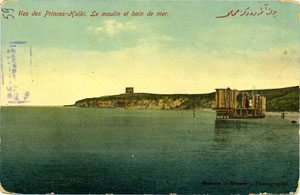
Halki, the Greek name of the island, which means "copper," comes from the copper mines that were worked here in antiquity, mentioned by Aristotle. The island took its Turkish name, Heybeli, from the word for saddlebag, heybe, which it is said to resemble because of the shape of its hills and their intervening valleys.
In Byzantine times, there were at least three monasteries on Heybeliada, then known as Halki. The most renowned of these was Hagia Triada, the Holy Trinity, whose site on Ümit Tepesi is occupied by the Greek Orthodox theological school of the same name, a direct descendant of the original Byzantine monastery. The present monastery is the most prominent monument on Heybeliada, dominating the view from an approaching ferry and from within the village itself.
The earliest reference to a monastery on Halki is in the writings of St. Theodore of Studius early in the ninth century. Theodore, abbot of Constantinople’s famous monastery of St. John of Studius, was exiled to a monastery on Halki by Leo V (r. 813-20) because of his criticism of the emperor’s iconoclastic policy. While on Halki, Theodore wrote a number of letters, theological treatises, and poems, one of which was addressed fondly to the monastic cell in which he was confined. Theodore does not name the monastery, but other evidence would seem to indicate that it was the Holy Trinity. Theodore’s letters say that after Leo V was assassinated in 820, his widow, the empress Theodora, and her daughters were exiled to the monastery on Halki by the new emperor, Michael II. Theodore and the other residents of the Holy Trinity were then evicted to make way for the empress and her daughters. Thus there would seem to have been another monastic establishment on Halki where the displaced monks could find shelter, and it has been suggested that this was the monastery of St. John the Baptist.
Burgazada - Antigoni
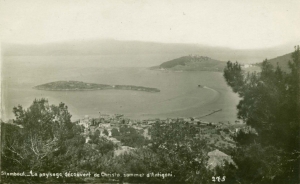 In antiquity the island was known as Panormos, but in Byzantine times it was called Antigoni, the name still used by the Greeks. The Turkish name of Burgaz is a corruption of the Greek pyrgos, or tower, from an ancient watchtower on its summit that is mentioned by Evliya Çelebi and other travelers up until the early nineteenth century. The watchtower can be seen on the summit of the island in an engraving done in 1794 by Cosimo Comidas. The engraving shows the island bare except for what appear to be an orchard and two or three cultivated patches on the side of the hill.
In antiquity the island was known as Panormos, but in Byzantine times it was called Antigoni, the name still used by the Greeks. The Turkish name of Burgaz is a corruption of the Greek pyrgos, or tower, from an ancient watchtower on its summit that is mentioned by Evliya Çelebi and other travelers up until the early nineteenth century. The watchtower can be seen on the summit of the island in an engraving done in 1794 by Cosimo Comidas. The engraving shows the island bare except for what appear to be an orchard and two or three cultivated patches on the side of the hill.
In more recent times, the island was densely wooded, principally with pines. Unfortunately, a fire in 2003 destroyed most of the trees above the village, but the area has been replanted with pine saplings.
The single hill, Hristos Tepesi (Christ Hill), also known as Bayraktepe (Flag Hill), rises to a height of 170 meters in the middle of the island. The center of the village is on the northeast coast of the island, its houses stretching from there along the heights above the northern shore. The shore roads extend around all of the island except its inhospitable south coast, where precipitous cliffs hang over the sea.
During Byzantine times there were at least two monasteries on the island, one of them dedicated to St. John the Baptist (Hagios Ioannis Prodromos), and the other to the Transfiguration of Christ, but neither seems to have housed any royal exiles.
The earliest reference to the monastery of St. John is in the diary of the Reverend John Covel, who in his entry for 2 May 1675 writes: "There hath been a monastery upon Antigono, but now it is decaid, and shrunk to a little church dedicated to St. John." Covel visited the island again on 2 April 1677, when he made the following entry in his diary: "That evening about 5 a clock, we set sail from Pera, and came to Antigono, where we lay in a poor tavern. The town is not worth any notice. The wine is ordinary...the water very bad; bread dear and not very good."
The only famous personage exiled on Antigoni during the Byzantine period was St. Methodios the Confessor, Patriarch of Constantinople (r. 842-6), who was imprisoned in the monastery of St. John by Michael II, the Stammerer, during the years 822-9 because of his opposition to the emperor’s policy of iconoclasm. After Michael’s death in 829 his son and successor, the emperor Theophilos (r. 829-42), released Methodios and allowed him to return to Constantinople. Methodios was elected patriarch in 842 and the following year he convened a Church Council that restored the veneration of icons, ending the Iconoclastic Period. After Methodios died in 846 he was canonized, his body having been laid to rest in the church of the Holy Apostles among the tombs of the Byzantine emperors.
Kınalıada - Proti
 The Greeks have always called the island Proti, or First, since it is the nearest of the islands to the city. It is the smallest of the four major islands, with an area of 1.356 square kilometers.
The Greeks have always called the island Proti, or First, since it is the nearest of the islands to the city. It is the smallest of the four major islands, with an area of 1.356 square kilometers.
The Reverend John Covel, chaplain of the Levant Company in Galata, made two voyages out to the islands in 1676-7, and on the second of these he observed that the village on Proti had been destroyed and abandoned, though there is no record of what catastrophe might have been responsible for this. As Covel writes in his entry for 26 February 1677:
We left Chalcis [Halki]. We past by Antigono [Antigoni], and came to Prote [Proti]. There is no village there, but onely a monastery on the top dedicated to our Saviour, Haghios Sotir. They have all the island to themselves. There is no vineyards, it being most rocky barren ground. It is decimated, and hath a stavromenos [a monastery belonging to one on Mount Athos]. There are about ten or fifteen kaloyeri [monks]. They had a fine herd of goats, and then above thirty young kids in their mandra [enclosure for cattle]. There are good olives, flax, and some corn ground. There is on the east side going up a pond, but the water is not good or lasting all the year, proceeding onely from the rain or snow, and not regarded or preserved as a cistern. On that side there hath been a town, but all is now level’d with the ground. On these islands there are wells or cisternes, and as good water as can be drunk.
The monastery described by Covel is one of several known to have been founded on Proti in Byzantine times. The one that he describes was dedicated to the Transfiguration of the Saviour (Metamorphoseos tou Sotiros) and housed several distinguished exiles, including a number of emperors and empresses of Byzantium.
The first of these exiles was the Armenian general Bardanes, who in 803 revolted against the emperor Nicephorus I (r. 802-11). The army proclaimed Bardanes emperor and he advanced upon Constantinople, but as his troops approached the capital they began deserting to Nicephorus. Bardanes was persuaded to surrender to Nicephorus, who had him blinded and exiled to Proti, where he spent the rest of his days as a monk, perhaps in a monastery that he founded himself.
The emperor Michael I Rhangabe (r. 811-13) was deposed by his Armenian general Leo, who succeeded to the throne as Leo V (r. 813-20). Leo sent Michael off into exile to the monastery of the Transfiguration on Proti. Michael was accompanied in his exile by his wife, the empress Procopia, and their four children, two daughters and two sons. Procopia and her daughters took the habit as nuns, while Michael and his two sons, Theophylact and Nicetas, became monks, the two boys being castrated so that they could never succeed their father as emperor. Michael died on Proti in 840 and was buried in the monastery graveyard. Nicetas, who took the name Ignatius when he became a monk, eventually was allowed to leave Proti and served two terms as patriarch of Constantinople (847-58, 867-77); after his death he was canonized as a saint in the Orthodox Church.
Leo was assassinated in 820 by Michael the Amorian, who succeeded to the throne as Michael II. Michael then exiled Leo’s widow, Theodosia, and her four children to the monastery of the Panagia, or Holy Virgin, on Proti, where the remains of the deposed emperor were buried.
Romanus I Lecapenus (r. 919-44), an Armenian, was overthrown on 17 December 944 by his sons Stephen and Constantine, who then had themselves crowned as co-emperors and sent their father into exile in the monastery of the Transfiguration on Proti. But then on 27 December Stephen and Constantine were themselves deposed and sent off into exile at the same monastery. Romanus died there on 15 June 948, while Stephen and Constantine were subsequently sent off into more distant exile on an island in the Aegean, where they were confined in a monastery for the rest of their days.
Romanus II (r. 959-63) scandalized Byzantium by marrying a beautiful courtesan named Theophano. When Romanus died in an accident in 963 Theophano married his successor, Nicephorus II Phocas (r. 963-9), an Armenian general. Six years later Theophano and her lover John Tzimisces, another Armenian general, conspired to assassinate Nicephorus, whom they killed on 10 December 969. The following day Tzimisces was crowned as the emperor John I (r. 969-76). Theophano thought that he would marry her and that she would become an empress for the third time, but Tzimisces exiled her to a monastery on Proti, where she remained for the rest of her life.
Romanus IV Diogenes (r. 1067-71) was deposed in 1071 after his catastrophic defeat by the Seljuk Turks at the battle of Manzikert. His successor, Michael VII Doucas (r. 1071-8), blinded Romanus and exiled him to the monastery of the Transfiguration on Proti, where he died on 4 August 1072.
Kınalıada has three peaks, with Çınar Tepesi (Plane Tree Hill) rising in the northeast of the island to an elevation of 115 meters, Teşrifiye Tepesi (110 m.) in the center, and Manastır Tepesi (93 m.) in the south. All three hills are almost treeless but are covered with brush, just as they appear in an engraving of the island done in 1794 by Cosimo Comidas. The engraving shows two of the hills crowned with large structures which are undoubtedly monasteries, one of them overshadowed by an enormous cypress. Teşrifiye Tepesi is now studded with a dozen television and communications antennae, an unsightly reminder that the modern world has penetrated these once idyllic isles.
Kınalıada is the most barren of the four major islands, as Grosvenor notes in his description of its appearance, where he interprets its topography in terms of two hills rather than three and gives it three monasteries:
Proti, the First or Nearest, consists of two prolonged and lofty mounds. A belt of trees spans the hollow. No water-springs refresh its bare and arid surface. Stunted shrubbery and a few straggling houses cling like moss along the slopes. Its very appearance is suggestive of the sorrows and tragedies it has seen, all accomplished within the walls of three monasteries between which the island was shared.
Sedefadası - Antirovithos
The name of the island is said to derive either from sedef (mother-of-pearl) or from sedefotu, the rue plant commonly found here.
St. Ignatius founded a monastery for men on Antirovithos in the mid-ninth century, one of three monastic establishments he built on the Princes’ Isles, all of which are mentioned in the list made by Manuel I Comnenus in 1158. The monastery on Antirovithos was restored in 1180 by the patriarch Theodosius Boradiotis. All that remains of the monastery today is a fragmentary ruin on the northwestern promontory of the island.
During the reign of Mahmut II (r.1808-39) the island was given over to the sultan’s son-in-law, Rodosizade Damat Fethi Ahmet Paşa, who planted two thousand olive trees and five thousand artichoke plants.
The Smaller Islands
Sivriada - Oxia
Despite its small size, Oxia (Sivriada) had its monastery, of which some remnants have survived. This establishment is mentioned in the list of monasteries compiled in 1158 by the emperor Manuel I Comnenus. The monastery had two churches: a katholikon of the Archangel Michael and a chapel dedicated to a number of martyred saints. Several abbots of the monastery subsequently became patriarch of Constantinople. Substantial ruins of the monastery can still be seen on the hillside beside the quay on the inner side of the port.
The earliest mention of the island in Ottoman times is by Petrus Gyllius, who stopped there in 1545. The island’s chief fame in modern times is that on several occasions all the wild dogs of Istanbul were rounded up and exiled there, where they soon ate each other up.
Yassıada - Plati
Yassıada measures 300 by 190 meters, with a maximum elevation of forty meters. It too had its monastery, founded in the mid-ninth century by St. Ignatius, who was twice patriarch of Constantinople (847-58, 867-77). The monastery, mentioned by Manuel I Comnenus in his listing of 1158, had a katholikon dedicated to the Forty Martyrs and also a chapel of the Virgin. Ernest Mamboury, writing in his 1943 guide to the Princes’ Isles, reports that he found remnants of one of these churches, whose ruins now seem to have vanished.
Sir Henry Bulwer, British ambassador to the Sublime Porte, purchased Yassıada in 1857 with the intention of developing it as a market garden. At the time his mistress was Eurydice Aristarchi, Princess of Samos, for whom he erected what Mamboury calls a chateau moyennageux (medieval chateau), where Bulwer and his entourage were popularly believed to have indulged in "nameless orgies.
Kaşıkadası - Pita
Kaşıkadası is the smallest of the nine islands of the archipelago and its highest point a mere eighteen meters above sea level. It has no known history, and it was the only isle in the archipelago that did not have a monastery in Byzantine times.
Tavşanadası - Neandros
Small though it is, Neandros was the site of a monastery, founded in the mid-eighth century by St. Ignatius, son of the emperor Michael I and twice patriarch of Constantinople, who spent his last years in his monastery on Neandros, where he died and was buried in 877. The monastery is mentioned in the list made in 1158 by Manuel I Comnenus. The empress Theodora, wife of the emperor Theophilus (r. 829-42), was confined to the monastery on Neandros in 856 by her son Michael III (r. 842-67), the Sot, for whom she had served as regent until he came of age. Michael VII Doucas (r. 1071-8) was confined to the monastery after he was deposed and blinded in 1078, and he remained there until his death in 1090. The fragmentary ruins of the monastery can still be seen on the island, which is totally uninhabited.
Vordonosadası - Vordonosi
Tiny though it is, it too was the site of a Byzantine monastery, founded in the second half of the ninth century by the patriarch Photius.


 Transportation
Transportation 